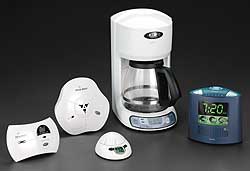In 1999, Sunbeam (Sunbeam, Oster, First Alert, Mr. Coffee, etc.) wanted to create a line of smart appliances that would talk to each other and the Internet. Sundberg Ferar, their industrial design firm, suggested that Sunbeam give me a call.
Motivation
Sunbeam was in trouble due to the disastrous management by “Chainsaw Al” Dunlap that left them with two billion in debt. Jerry Levin had taken over and was looking for ways to save the company. He explained that while running Revlon, he had the R&D department develop a new lipstick that would last all day, far longer than the competition. It worked, and their sales margins and profits increased dramatically. And Revlon rose from third to first in cosmetics market share. My job was to do something similar for Sunbeam’s appliance lines to give them a boost.
When you go to an appliance store to buy a coffee maker or curling iron, you will find very similar products from several different brands. Since their features are often nearly the same, you buy based on price, looks or reputation. With stiff price competition, all the appliance manufacturers had slim margins. But if one of the appliances on the shelf had some cool new feature, it would stand out, sell more and could command a higher price.
So Sunbeam’s idea of making the appliances talk to each other and the Internet had a lot of promise. Their initial plan of how to pull it off did not.
A Heavy-Handed Approach
Sunbeam’s strategy was to sell a dedicated PC in a box that would serve as the hub for all the appliances, and a gateway to the Internet. It would connect to the appliances through WiFi. This was the most obvious and straightforward approach. But I told them that I thought it would be a commercial failure for many reasons:
- Such a PC would have cost a couple thousand dollars back then. Who would spend that much to hook up some $30-50 appliances?
- WiFi was uncommon in homes at the time. So the consumers would have to buy that and figure out how to set it up too.
- WiFi hardware was way too expensive. If Sunbeam wanted their smart appliances to stay within $10 or $20 of the base product, the manufacturing cost of the extra hardware had to be under a few dollars.
- WiFi used too much power. In products like their First Alert smoke alarms, the battery would be dead within minutes.
- Their customers were used to products that just plugged into the wall and worked, not that required large manuals and an IT department to set up.
An Improved Architecture
My proposal was to eliminate the PC altogether and use a very inexpensive hub instead. And we’d replace the WiFi communications with a much cheaper and easy to set up networking scheme.

I argued that an inexpensive alarm clock could take the place of the PC as the hub of the system. Smartphones hadn’t been invented yet, so nearly everyone still had an alarm clock next to their bed. It was a logical place to check on the status of everything and turn things on and off when you went to bed or woke in the morning. As a clock, it was perfect for scheduling when your electric blanket turned off and your coffee maker started in the morning, for example. And with a cheap dial-up modem, we could download weather and traffic information early in the morning, ready for when you woke up.
High-speed communications are important for streaming videos and sending large files, but are overkill for a few dozen bytes to broadcast when the dryer is done or your coffee maker is out of water. So we would use inexpensive low data rate powerline and wireless communications rather than WiFi. If the product plugged into the wall, it would talk through the house wiring. And if it ran on batteries, then it would use short bursts from an ultra-low power radio to talk.

This scheme meant that a customer could get a starter kit of networked appliances for $80 or less, such as an alarm clock plus a coffee maker, or alarm clock and a smoke alarm. They would try it out, see the benefits, and then start buying more smart appliances to add to the system.
Thalia Products
Sunbeam liked the idea, so I was contracted to create a suite of eight prototype products including the alarm clock and a touchscreen kitchen organizer within five months. We assembled a team and pulled it off, and were the hit of the annual Housewares Show in Chicago. I then joined Sunbeam as Chief Technology Officer of their new tech division, Thalia, and later became VP of Technology for the corporation.
My role was to develop the technologies (such as the low-cost communications circuits that we called HLT, or Home Linking Technology) and coordinate the incorporation into the products of the different divisions within Sunbeam and to promote and sell it to other companies. Consumers would benefit if we were also able to communicate with products from other manufacturers. For example, we wanted our alarm clock to be able to control Lutron light switches, check that your garage door was closed or tell you when your Maytag dryer was done. That meant that we needed some standards for both the communications hardware and the messages that were passed between the devices.
AHAM
The Association of Home Appliance Manufacturers (AHAM) organized discussions about smart appliances and how to connect them. I chaired the committee that was writing the standard for the communications protocols, and we met every two to four weeks. Agreeing on the hardware was difficult since a company like Maytag or GE would be content with adding $20-30 to their cost for a high-end large appliance like a washing machine, while we wanted to keep it to a couple of dollars for our small appliances. But we were making good progress on the messaging protocols.
Someday I may write a blog post about my meeting with Bill Gates. Microsoft was trying to convince the AHAM members that we all needed to use some form of Microsoft operating system and an adaptation of their Universal Plug and Play (UPnP) architecture. I was arguing that we didn’t need all that complexity and to be paying licensing fees to Microsoft just to turn a light on or tell when your dishwasher was finished, and we had proven that it could be done. So Bill called me out to his office in Redmond to talk…
Sunbeam’s Demise
Unfortunately, that all came to an end for us when Sunbeam’s financial woes from Al Dunlap’s management caught up to it. In 2001, less than a year before we would have started selling the new products, Sunbeam filed for bankruptcy. It was sad that we didn’t get to finish, but I was very proud of what we were working on and what we accomplished.
Today, this type of work continues with the Internet of Things (IoT), the Cloud and other technologies to connect more and more of the devices and points of information in our lives. There are still many opportunities and a lot to be done.

